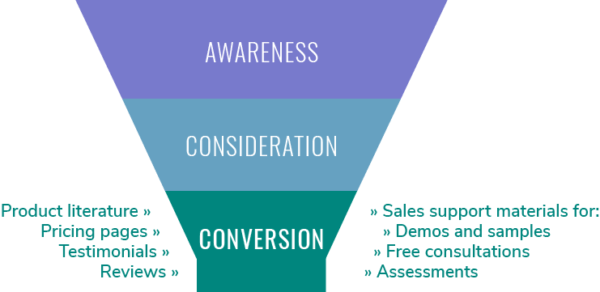All the content in your marketing funnel has led to this point. Your audience has been made aware of potential solutions to their problem(s) and educated about why your product/service is empirically better than others. Now it’s time to convince them to buy using content that converts.
Conversion: The Bottom of the Marketing Funnel
This is the stage where visitors are ready to convert to customers. The primary goal of this stage is a transaction, motivated and supported by unique value propositions, appeals to motivation triggers, and third-party proof of your solution’s value.
Bottom-of-the-funnel content isn’t likely to convert many visitors by itself; it’s like proposing on the first date. But when this content is the culmination of the engagement you’ve built throughout the visitor journey, it’s a progression that feels natural to visitors.
When Creating Content for Conversion
In the Awareness stage, the best tone for content is journalistic, while Consideration content calls for a scientific or professorial tone. Content that converts requires a salesperson.
Conversion content creation is the best time to engage Dr. Robert Cialdini’s Six Principles of Persuasion:
- Reciprocity: Not only have you provided consistently valuable content, you’ve demonstrated how much value your product/service can add to your customers’ lives. This helps the conversion feel fair to them.
- Consistency/internal alignment: Most people feel a need to make their actions consistent and in line with their beliefs and values, and most people also like to think of themselves as fair and ethical. Based on this principle, adding bonuses (including extra or exclusive content) will increase the visitor’s sense that they should convert.
- Social proof: The lower funnel stage is perfect for demonstrating social proof in the form of testimonials and reviews, demonstrating that objective third parties find value in your solution(s).
- Authority: You reap the reward of producing high-quality, informative content by establishing yourself as an authority on relevant topics. Generally, people prefer to buy from companies with clear expertise who are willing to share their insights.
- Likeability: If done well, your top- and mid-funnel content hasn’t just provided consistent value to visitors, it’s done so in an appealing tone. This makes it easier for visitors to trust you when it’s time to convert.
- Scarcity: This might feel a little underhanded, but it’s historically been proven to work for most segments and offers. Phrases like “limited time,” “limited edition,” or “only [number or length of time] left” encourage visitors to act as soon as possible before the offer disappears. One caveat: if you use these tactics, retain your brand’s integrity and likeability by changing the offer after the clock has run out.
Best Formats for Bottom-of-Funnel Content
 Lower-funnel marketing content can be much shorter than content higher up the funnel. There’s a real danger of “selling past the close,” when too much information overwhelms the customer once they’ve already decided to buy. Instead, give them the information they need to purchase, then allow them to make the choice.
Lower-funnel marketing content can be much shorter than content higher up the funnel. There’s a real danger of “selling past the close,” when too much information overwhelms the customer once they’ve already decided to buy. Instead, give them the information they need to purchase, then allow them to make the choice.
Good formats for content that converts include:
- Product literature: More information could be necessary at this stage for long sales cycles and products requiring a significant investment,. Because product literature is often brought in near the bottom of the funnel, it should always be considered marketing material, and that includes data sheets and usage guides. While the latter two are usually developed by technical teams, they should be reviewed by your marketing or content team to ensure you’re capturing all their conversion potential.
- Testimonials: This is the social proof mentioned in Cialdini’s Six Principles. It bolsters your image as a provider of quality solutions and good customer service. The problem with testimonials is that you have to ask for them, so make that a consistent action for your customer-facing team.
- Reviews: As with testimonials, reviews often need to be prompted (especially positive ones). Fortunately, the content on your website is yours to determine, so you’re free to include only positive reviews in your bottom-funnel content (as opposed to off-site listings, where negative reviews stay up and you must respond to them).
- Pricing pages: These pages can have the biggest impact on conversions, so treat them as the important content they are. In a comparison chart, it’s fine to list features in brief language, but have each item on that list link to explanations farther down the page that highlight the benefits of each feature. This lets you convey how much cumulative additional value customers can get at higher price levels.
- Sales support materials (demos/samples, assessments, consultations): These items might not seem like they fall under the “content” umbrella, but they are yet another place where content that converts is crucial. Here, your content team can ensure consistency between marketing and sales messages, boost the conversion potential of guides for demos or samples, provide conversion-oriented context for assessment results, and make many other positive contributions.
If you’d like to discuss how to get the most potential out of your marketing funnel, let’s talk about how a smart content strategy can give you better results.

